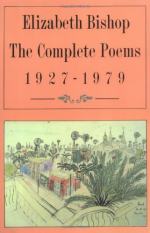
|
| Name: _________________________ | Period: ___________________ |
This quiz consists of 5 multiple choice and 5 short answer questions through Section 1: "One Art" lines 1-19.
Multiple Choice Questions
1. What kind of metrical foot is the most frequent in "One Art"?
(a) Spondee.
(b) Dibrach.
(c) Trochee.
(d) Iamb.
2. What does the colon at the end of line 7, "Then practice losing farther, losing faster," indicate about the "places, and names" in line 8?
(a) Places and names are more upsetting to lose than small objects and small amounts of time.
(b) Places and names are examples of things a person can only lose through "practice" and experience.
(c) Places and names are examples of things that can be lost "farther" and "faster."
(d) Places and names are some of the last things that a person loses.
3. In line 10, what does the speaker admit to having lost?
(a) Their wedding ring.
(b) Their child's artwork.
(c) Their mother's watch.
(d) Their college diploma.
4. What does the speaker use in line 5 as an example of a common lost object?
(a) Glasses.
(b) Keys.
(c) Pens.
(d) Socks.
5. Which is a reasonable statement of how the punctuation and syntax of the final stanza affect the stanza's tone?
(a) They create a choppy sound that indicates anger.
(b) They accelerate the pace as the stanza unfolds, creating a sense of urgency.
(c) They slow its pace and create a sense of uncertainty.
(d) They create a rolling rhythm that invokes the light, carefree tone of a nursery rhyme.
Short Answer Questions
1. What does the second stanza suggest the "art" of losing consists of?
2. In line 7, "Then practice losing farther, losing faster," rhythm is created through which devices?
3. Who is the author of "One Art"?
4. Stanzas four through six have which techniques in common?
5. What is the name of the metrical foot that appears at the end of lines 1 and 3 in most of the stanzas?
|
This section contains 323 words (approx. 2 pages at 300 words per page) |

|




